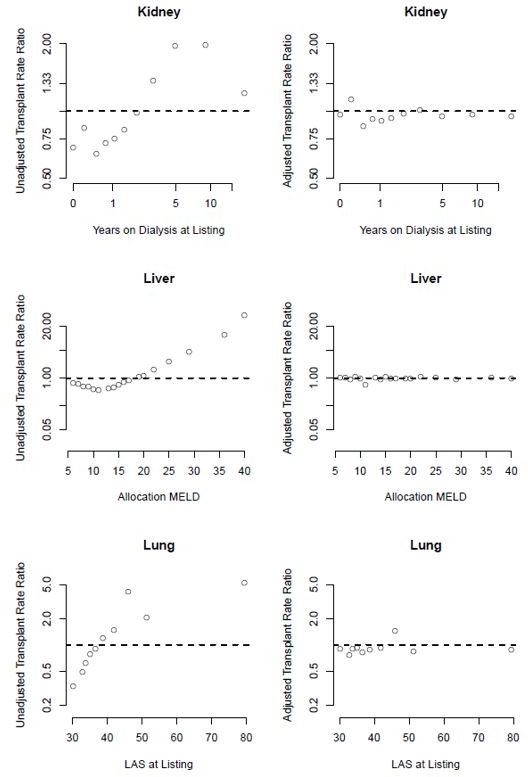Program-Specific Transplant Rate Ratios: Association with Allocation Priority at Listing and Posttransplant Outcomes
SRTR, Mineapolis.
Meeting: 2018 American Transplant Congress
Abstract number: B298
Keywords: Kidney, Liver, Methodology, Public policy
Session Information
Session Name: Poster Session B: Non-Organ Specific: Economics, Public Policy, Allocation, Ethics
Session Type: Poster Session
Date: Sunday, June 3, 2018
Session Time: 6:00pm-7:00pm
 Presentation Time: 6:00pm-7:00pm
Presentation Time: 6:00pm-7:00pm
Location: Hall 4EF
The Scientific Registry of Transplant Recipients (SRTR) has updated the transplant rate and waitlist mortality risk-adjustment models to include a wider range of candidate characteristics and explicitly adjust for allocation priority at listing. With the updated models, we evaluated the potential association between transplant rate and allocation priority at listing that could allow programs to manipulate transplant rates by denying access to low-priority candidates. Further, we evaluated the association of adjusted transplant rate ratios with adjusted waitlist mortality rate ratios and posttransplant hazard ratios because correlated metrics provide redundant information and could reduce the utility of public reporting. The analysis used cohorts from the January 2017 SRTR program-specific reports. Despite a strong association with unadjusted transplant rates, there was no candidate-level association between allocation priority at listing and adjusted transplant rate ratios (Figure 1). In kidney transplantation, higher program-specific adjusted transplant rate ratios were weakly associated with better posttransplant outcomes (r = -0.14; P = 0.035) and lower waitlist mortality (r = -0.15; P = 0.022), but these associations were absent in liver, lung, and heart transplantation (Table 1). Thus, program-specific adjusted transplant rate ratios are not manipulated by denying access to candidates with low allocation priority, and the weak associations between transplant rate, waitlist mortality, and posttransplant outcomes suggest that each metric addresses a different dimension of the patient experience.
 Figure 1. Candidate-level association of allocation priority at listing with unadjusted and adjusted transplant rate ratios. Heart transplantation was not included because there was no continuous measure of allocation priority.
Figure 1. Candidate-level association of allocation priority at listing with unadjusted and adjusted transplant rate ratios. Heart transplantation was not included because there was no continuous measure of allocation priority.
CITATION INFORMATION: Wey A., Gustafson S., Salkowski N., Pyke J., Kasiske B., Israni A., Snyder J. Program-Specific Transplant Rate Ratios: Association with Allocation Priority at Listing and Posttransplant Outcomes Am J Transplant. 2017;17 (suppl 3).
To cite this abstract in AMA style:
Wey A, Gustafson S, Salkowski N, Pyke J, Kasiske B, Israni A, Snyder J. Program-Specific Transplant Rate Ratios: Association with Allocation Priority at Listing and Posttransplant Outcomes [abstract]. https://atcmeetingabstracts.com/abstract/program-specific-transplant-rate-ratios-association-with-allocation-priority-at-listing-and-posttransplant-outcomes/. Accessed December 29, 2025.« Back to 2018 American Transplant Congress

